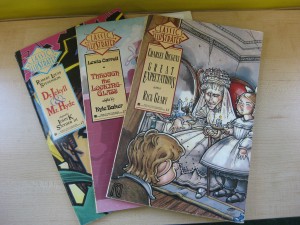On August 31st, I completed my book-a-day reading challenge. I feel a sense of accomplishment in the fact that I was able to meet this goal, and along the way I had some time to reflect (as teachers often do) on the entire experience. I have decided that there are several advantages to my summer endeavour:
1.) The goal made me make time for reading. The television wasn’t on nearly as much this summer as it was last summer. I would set aside time in the afternoons to lay on the couch and pick up a book. Sometimes, if I was too busy for a couple of days, I would devote an entire afternoon to reading. I have not done that since I was in grade school, and I liked the nostalgic feeling that it gave me. I realized that reading had been pushed aside in my daily routine because I thought I had no time, but this challenge showed me that if something is important and relaxing for you, then you should make time for it.
2.) I read books I wouldn’t ordinarily pick up. Once in a while I knew I needed to read a book for that day, and I just picked up whatever book happened to be there. As a result, I read several books that would normally escape my notice, and in most cases I am glad they are now part of my reading repertoire. I read at least six historical fiction novels that had been on my shelf for at least three years, and enjoyed every one. I read more non-fiction books. I was able to actually get through and return borrowed books to their owners, which is something that is usually a challenge in itself for me. Because I had to meet my goal, I became a more well-rounded reader by reading books that were not part of my typical to-read lists.
3.) Books I had been meaning to read for a while actually got read. The novels Crispin: The Cross of Lead, The Secret Life of Bees, and Kitchen are notables on this list. I felt an accomplishment in finally reading those novels that had been recommended to me by others or that I had continually seen on bookshelves. It taught me that if I really want to read a book, it was simply up to me to pick it up and begin.
4.) I made children’s books a priority. Sometimes I knew that I would be on vacation or just too busy on the weekend to delve into a chapter book. In those instances, I picked up a children’s book from my bookshelf. Reading these books reminded me how well-written these stories can be, and how even though I teach middle school I can use these stories to demonstrate how good stories are written and how reading strategies can be used.
5.) I can now recommend books to my students with some authority. On Thursday my class went to the library for the first time this school year. I moved around the shelves, and helped a few reluctant readers and avid readers with their book choices. I have been talking to students about books they have read and books that they would like to read. Students and I have been sharing our mutual love or dislike of books, and a few have given me book suggestions. This challenge has given me another way I can connect with my students.
6.) I continue to pick up books even though I have finished the challenge. The advantages above have convinced me that if I want to continue to teach Language Arts and espouse the merits of literacy, then I have to be well-read.
I really believe that I can complete this challenge again next summer. In the meantime, I will make sure that I will continue to pick up and read books that interest and delight me. Book reviews will continue to pop up on this site, or follow me on Goodreads to learn more about any past or future books.


